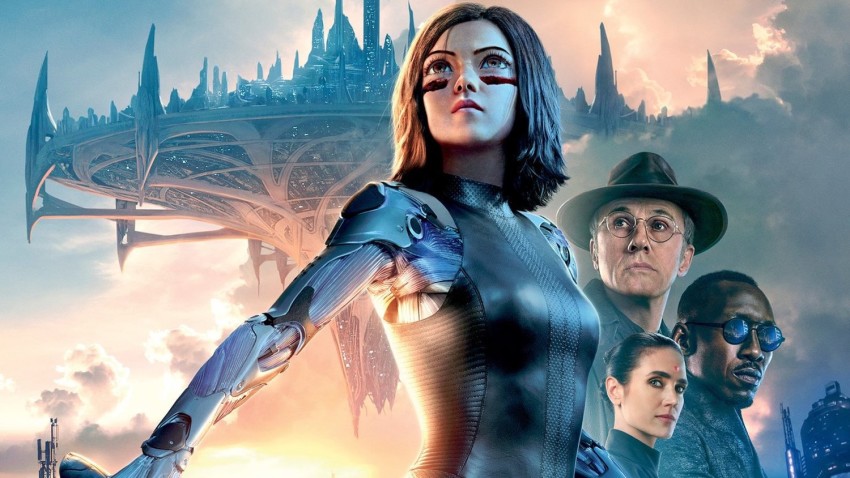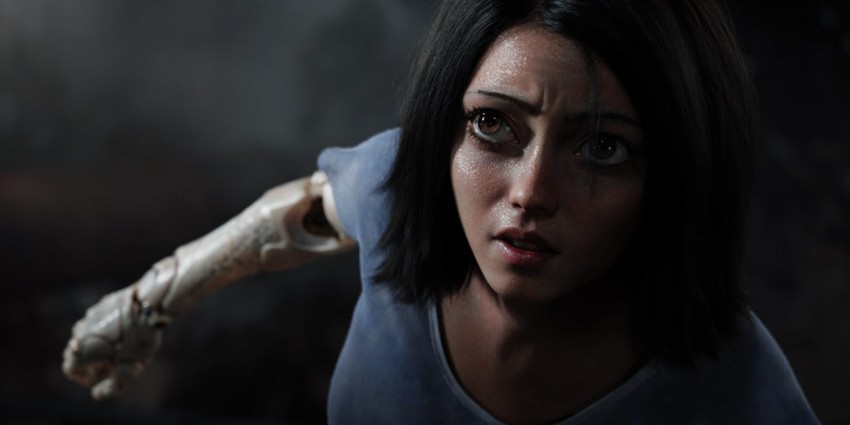Alita: Battle Angel
February 1, 2019 · 0 comments
By Andrew Osmond.
 Midway through Alita: Battle Angel, the cyborg heroine realises she’s provoked the mother of all bar brawls – with a crowd of horribly beweaponed cyborgs – and now must kick an ironmonger’s worth of metal ass. She cautions her human boyfriend Hugo (Keean Johnson) to stand back, way back. This line of dialogue gets one of the biggest laughs in the film. It’s also one of the points where this lavishly spectacular, generally enjoyable, tolerably lunk-headed film catches fire.
Midway through Alita: Battle Angel, the cyborg heroine realises she’s provoked the mother of all bar brawls – with a crowd of horribly beweaponed cyborgs – and now must kick an ironmonger’s worth of metal ass. She cautions her human boyfriend Hugo (Keean Johnson) to stand back, way back. This line of dialogue gets one of the biggest laughs in the film. It’s also one of the points where this lavishly spectacular, generally enjoyable, tolerably lunk-headed film catches fire.
Robert Rodriguez’s Alita is by far the most faithful version of a manga or anime property yet adapted by a Hollywood studio. Specifically it’s based on a 1990s SF manga by Yukito Kishiro, called Gunnm in Japan but renamed Battle Angel Alita in Anglophone territories. The strip’s heroine was also renamed. Alita was Gally in Japan and in the US dub of the anime version. The hour-long anime retold Alita’s early adventures in heavily compressed form. Made by the Madhouse studio, the anime’s future violence looks horribly dated now, and it’s only notable as an advert for Kishiro’s manga.
Hollywood’s own manga adaptations are despised by many fans, for whitewashing and cultural appropriation. They may also be hated for mainstreaming; it’s easy to resent seeing a comic-shop cult favourite being gentrified for the multiplex. Still, the Alita film’s first moments are awesome if you know the Japanese versions. A pristine floating city from an Amazing Stories cover shits out garbage on a town below. In the gargantuan junkyard, a middle-aged scavenger finds the head and shoulders of a still-living girl. Alita fans have seen this scene done as a manga spread, and done again, far less attractively, in anime. But now we’re seeing the scene redone with Avatar-level picture quality, a whole order of cinematic immersion above anything in the live-action Ghost in the Shell. Alita’s opening should be savoured, for all the film’s shortcomings.
 Alita’s human brain is housed in an artificial head, with unnaturally big eyes. No doubt countless reviewers will note an irony in the casting. Alita’s adult rescuer is played by Christoph Waltz, who most viewers know from Inglourious Basterds and Django Unchained. But he also played a deceitful artist claiming credit for painting huge-eyed girls in Tim Burton’s Big Eyes. In Alita, his character is called Dyson Ito (altered from Daisuke Ito in the manga). A cyborg expert, though not a cyborg himself, Ito furnishes Alita with an artificial body, and wakes her up.
Alita’s human brain is housed in an artificial head, with unnaturally big eyes. No doubt countless reviewers will note an irony in the casting. Alita’s adult rescuer is played by Christoph Waltz, who most viewers know from Inglourious Basterds and Django Unchained. But he also played a deceitful artist claiming credit for painting huge-eyed girls in Tim Burton’s Big Eyes. In Alita, his character is called Dyson Ito (altered from Daisuke Ito in the manga). A cyborg expert, though not a cyborg himself, Ito furnishes Alita with an artificial body, and wakes her up.
Within a few moments, it’s obvious what Alita really is. She may be a CG creation, motion-captured for the film from actor Rosa Salazar, but to all intents and purposes, she’s a living puppet, a girl Pinocchio. She has a half-human, half-mannequin gait, a blank-slate memory, a wonderment at the world, and a smiling naivety that could only belong to a cartoon character. Alita’s performance, unlike her appearance, is unexceptional at first; it’s only later she shows intense joy and fury. Moreover, Alita develops at the film’s halfway point, in a way that charmingly mixes artifice with organic growth; this should resonate for adolescents and their parents.
Alita’s surroundings are the film’s biggest all-encompassing spectacle. It’s an endless stone beehive of streets, passages and rooftops that Rodriguez depicts like the Pandora of his producer James Cameron – massively crowded and bustling, believably lived in, another of Alita’s pure pleasures. Here Alita has her first encounters with other youngsters (with more shades of Pinocchio), including a gang of extreme skaters practicing for a ballgame called Motorball. Alita also investigates Ito’s work, which draws her into the city’s underbelly of serial killers, limb-chopping gangs and bounty hunters. Such is Alita’s lifestyle that she experiences her first crush, on Hugo, around the same time she learns she also has her own knack for killing, with glimpses of a past life where she gained it.
 The film follows the manga extremely faithfully by Hollywood standards. Given the film has a 12A certificate, it’s inevitable that many of the manga’s gruesome images are excised, but this is still the high end of 12A. There is bisection, dissection and bloodletting. Much of the blood flows cyborg blue, but not always. For some viewers, the biggest, most unforgiveable shock will be the identity of a character that dies so that Alita can paint red blood on her face, as shown in the poster. Alita draws mostly on the first two manga books, which were also the basis for the anime. But the film also has a sub-plot that was added for the anime, involving a woman doctor (Chiren) who was Ito’s former partner but now keeps shadier company.
The film follows the manga extremely faithfully by Hollywood standards. Given the film has a 12A certificate, it’s inevitable that many of the manga’s gruesome images are excised, but this is still the high end of 12A. There is bisection, dissection and bloodletting. Much of the blood flows cyborg blue, but not always. For some viewers, the biggest, most unforgiveable shock will be the identity of a character that dies so that Alita can paint red blood on her face, as shown in the poster. Alita draws mostly on the first two manga books, which were also the basis for the anime. But the film also has a sub-plot that was added for the anime, involving a woman doctor (Chiren) who was Ito’s former partner but now keeps shadier company.
But Chiren exemplifies Alita’s shortcomings. She’s played by the laughably overqualified Oscar-winner Jennifer Connelly, who doesn’t get a single decent scene in the film. Nor do the vast majority of the cast; their worst scenes are big-budget pabulum at its most lifeless and anonymous. Even Waltz, who was so terrific playing loose-cannon chancers for Rodriguez’s chum Tarantino, is only functionally fatherly as Ito. A few of the cyborg heavies have one-joke moments, but otherwise the film relies on Alita’s charisma and her film’s action set-pieces.
But even the set-pieces are uneven. They’re staggered through the film in a risky build-up that risks losing viewers early. The teens’ early skating game is especially weak, while the first deadly battles, introducing Alita’s superhuman fight skills, are weightless CG fare. It’s not until the bar brawl, which is a dangerously far into the film, that the action suddenly has a physical impact, some remaining when the fight mutates into something more preposterous. In similar fashion, our first sight of the deadly Motorball game is a dull disappointment. It’s only later that we experience what it should be like, as part of another gaily extended action-chase scene.
Alita’s also saddled with a script that has next to no good lines, and reams of hokey ones. The visuals are spectacular, but without humour or lyricism. For hostile critics, Alita may look like no more than a rehash of the unloved live-action Ghost in the Shell. Not only is this another saga of a kick-ass cyborg heroine, but the Ghost remake took the story nearer to Alita, by giving its cyborg amnesia, mystery origins and human parent figures like a motherly Juliette Binoche.
At least the Ghost remake had a clear ending to its story. One of Alita’s biggest risks is that it practically ends with a “To Be Continued” notice, not wrapping up its conflict, not ending the adventure, and gambling that the film won’t be another Golden Compass flying into oblivion. The audience at the London preview screening greeted Alita’s end-credits with cheers and applause, but the critical consensus won’t be as kind, and the box-office prospects are cloudy. It’s only been weeks since another post-apocalypse blockbuster crashed and burned in Mortal Engines. I enjoyed Alita, and wish the film luck, but I wouldn’t bet on Alita’s adventures continuing outside of manga.
Andrew Osmond is the author of 100 Animated Feature Films. Alita: Battle Angel opens around the UK next week.
Leave a Reply